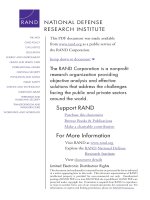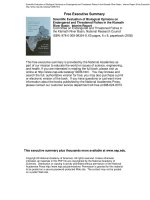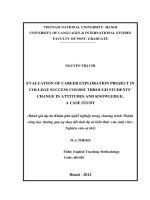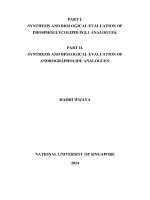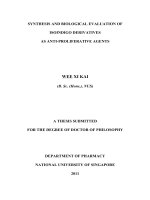Evaluation of fungicides, bio-agents and botanicals against Rhizoctonia spp. Incitant of sheath blight of rice
Bạn đang xem bản rút gọn của tài liệu. Xem và tải ngay bản đầy đủ của tài liệu tại đây (246.15 KB, 8 trang )
Int.J.Curr.Microbiol.App.Sci (2020) 9(8): 3039-3046
International Journal of Current Microbiology and Applied Sciences
ISSN: 2319-7706 Volume 9 Number 8 (2020)
Journal homepage:
Original Research Article
/>
Evaluation of Fungicides, Bio-agents and Botanicals against
Rhizoctonia spp. Incitant of Sheath Blight of Rice
Punam N. Usendi*, G. K. Giri and Sumant H. Kabade
Department of Plant Pathology, Dr.Panjabrao Deshmukh Krishi Vidyapeeth,
Akola- 444104 (M.S.), India
*Corresponding author
ABSTRACT
Keywords
Sheath blight, Rice,
Rhizoctonia,
Fungicides, Bioagents botanicals
Article Info
Accepted:
24 July 2020
Available Online:
10 August 2020
Sheath blight is a destructive disease in all rice crop growing areas of the world. The
present investigation was carried out to test the efficacy of fungicides, botanicals and
bioagents. Among fungicides tested Propiconazole 13% + Difenoconazole 13.9% SC,
Propiconazole 25% EC, Tebuconazole 50% + Trifoxystrobin 25% WG, Hexaconazole 5%
EC and Carbendazim 50% WP completely inhibited the radial growth of R. solani. The
fungicide Azoxystrobin (21.11%) and Validamaycin (30.37%) found least effective. In
vitro studies revealed that, all the four bio-agents were effective against the pathogen. The
order of per cent inhibition of the fungus are Trichoderma reesei (73.04%) > Trichoderma
asperellum (71.38%) >Pseudomonas fluorescens (64.44%) > Bacillus subtilis (61.38%).
Among six botanical extracts (10%) evaluated against R. solani, complete inhibition of the
fungal mycelium was observed in garlic bulb extract which was significantly superior to
rest of the treatments.
Introduction
Rice is an important crop worldwide, serving
as the staple food for half of humanity and
additionally being used in industry and for
animal feed. Rice is grown in various agroecological zones in tropical and subtropical
areas, especially in Asia, the continent
accounting for 90% of the world production
(IRRI, 2015a). India is the world‟s second
largest rice producer and consumer next to
China. About 90 per cent of rice grown in the
world is produced and consumed in Asian
continent. The production of rice to be
achieved by 2020 is 128 Mt to feed the
growing population in India. To meet the
global demand, it is estimated that about 114
Mt of additional milled rice needs to be
produced by 2035 with an increase of 26% in
next 25 years (Anonymous, 2016). In
Maharashtra, rice is cultivated on 15.13 lakh
hectares in regions viz. Vidarbha (7.95 lakh
ha.), Konkan (3.83 lakh ha.), Western
Maharashtra (3.23 lakh ha.) and Marathwada
(0.12 lakh ha.) with annual production of
41.71 lakh tones.
Rice production worldwide is affected by
various biotic and abiotic stresses (Richa et
al., 2016). Sheath blight of rice caused by a
3039
Int.J.Curr.Microbiol.App.Sci (2020) 9(8): 3039-3046
soil-borne fungal pathogen, Rhizoctonia
solani (Kuhn) is a destructive disease in all
crop growing areas of the world. Sheath
blight of rice caused by Rhizoctonia solani is
one of the major biotic constraints in India
and reduce rice yield ranging from 20-50%
depending on the severity of the disease and
stages of infection. The disease has spread
widely in terms of both occurrence and
intensity over past 20 years.
Materials and Methods
Isolation and pathogenicity
Fresh samples of diseased leaves, showing
sheath blight symptoms were brought to the
laboratory in paper bags. These samples were
washed with running tap water to remove
inert material. Small bits of desired size were
cut by taking care that each bit contained half
infected and half healthy portion. Such bits
were then disinfected with 0.1 per cent
sodium hypo chloride solution for 1 minute
followed by three washings in distilled sterile
water to remove the traces of mercuric
chloride. These bits were then placed on
sterilized blotters for drying. Properly dried
bits were transferred aseptically in sterilized
Petri plates containing sterilized, solidified
PDA medium. All the above operations were
carried out in sterilized condition (under
laminar air flow unit). Then plates were
incubated at 27 ± 2 ºC for 10 days. The fungal
growth, which developed around each bit,
was then transferred to PDA medium slant for
sub culturing. The isolated fungi were
identified as Rhizoctonia on the basis of
morphological characters and published
literature.
The pathogenicity of the isolates was
determined by injection method on 40-dayold susceptible rice cultivar Swarna. The
culture with fungal mycelia (and sclerotia)
was taken in a disposable syringe of 0.5ml
capacity then placed in between the tillers in
the central region of the hill, 5-10 cm above
the water line. Care was taken that no air
bubble was trapped in the suspension. Bigger
wounds were avoided at the point of injection.
Healthy uninoculated plants served as control.
The pathogen was reisolated on the PDA
medium from the symptomatic plants and
microscopic observations made were found
similar to that of the organism isolated from
naturally diseased rice plants. Thus, the test
pathogen was confirmed as Rhizoctonia
solani and pathogenicity of Rhizoctonia
solani was proved.
In vitro evaluation of
poisoned food technique
fungicides
by
Poisoned food technique was used to evaluate
the efficiency of seven fungicides against
pathogens. Potato dextrose agar medium was
prepared and distributed at the rate of 100 ml
in 250 ml conical flask, autoclaved
1.05kg/cm2 for 15 min. Then before
solidification of media different fungicides
with desired concentration were incorporated
aseptically in different flasks.
These flasks shaken to facilitate uniform
mixture of fungicides thoroughly and poured
in Petri plate‟s 20 ml/plate likewise three
plates for each treatment were poured. One
set of three plates was poured without any
fungicides to serve as a control. After
solidification of medium, the plates
inoculated with seven days old pathogens
separately. Five mm diameter mycelial disc
selected from peripheral growth of the plate
by sterilized cork borer were used for
inoculating the plates by keeping one disc per
plate in the centre in inverted position, so as
to make the mycelial growth touch the surface
of medium. The inoculated plates were
incubated at room temperature for seven days.
The colony diameter of the fungal pathogens
on medium was recorded and percent
3040
Int.J.Curr.Microbiol.App.Sci (2020) 9(8): 3039-3046
inhibition in each treatment was calculated by
using following formula (Vincent, 1927).
C -T
PI =x 100
C
Where,
PI = Percent Inhibition
C = Growth of fungi in control (mm)
T = Growth of fungi in treatment (mm)
In vitro evaluation of
poisoned food technique
botanicals
by
Aqueous leaf extracts of the test botanicals
were obtained by grinding the washed
rhizome and leaves (100 g) in mortal and
pestle with equal volume (100 ml) of
sterilized distilled water. The macerate
obtained was filtered through the folds of
muslin cloth and the filtrate obtained formed
100% phytoextracts, which were evaluated by
poisoned food method. Twenty ml of
poisoned medium was poured into each
stetrile petriplates. Five mm diameter
mycelial disc selected from periphery of
actively growing culture were cut out by
sterilized cork borer were used for inoculating
the plates by keeping one disc per plate in the
centre in inverted position, so as to make the
mycelial growth touch the surface of medium.
of each agar plate. Control was also
maintained by growing the pathogen on PDA
plates. The inoculated plates were incubated
at room temperature for seven days. The
colony diameter of the fungal pathogens on
medium was recorded and percent inhibition
in each treatment was calculated by using
above formula.
In vitro evaluation of bio-agents by dual
culture method
The lawn culture of test fungi and bio-agents
viz.,
Trichoderma
asperellum
and
Trichoderma
reesei
were
prepared.
Autoclaved, melted potato dextrose agar was
poured in petri plates and allowed to solidify
for obtaining leveled surface. The plates were
inoculated with the culture of test fungi and
bio-agents after solidification of media and
then plates were incubated at room
temperature for seven days.
Bacterial bio-agents, Bacillus subtilis and
Pseudomonas fluorescens were prepared by
inoculating a loopful culture in sterilized
conical flask containing 100 ml of nutrient
broth. Broth culture was incubated at room
temperature for three days. Five mm disc of
one week old test fungus and bio-agent lawn
culture was cut with the help of sterilized cork
borer lifted and transferred in petri plates,
containing autoclaved solidified PDA
medium. In each petri plates, four discs of
bio-agents were inoculated at four peripheral
points of the plates and the test fungi was
placed in the center of petri plates. In case of
Pseudomonas fluorescens and Bacillus
subtilis, a three days old culture was streaked
around the disc of test fungus. The test fungi
grown in same condition on potato dextrose
agar without bio-agents served as control. All
these plates were incubated at room
temperature for seven days. After an expiry of
seven days incubation period the mycelial
inhibition was calculated as per formula
mentioned in the poisoned food method.
Results and Discussion
Efficacy of fungicides against Rhizoctonia
solani
Seven fungicides were tested in laboratory
against Rhizoctonia solani for their efficacy
against radial growth. Data presented in table
1 clearly showed that all the fungicides taken
in this investigation were effective against R.
solani and significantly inhibited the radial
growth in vitro at different concentrations.
3041
Int.J.Curr.Microbiol.App.Sci (2020) 9(8): 3039-3046
Out of which Propiconazole 13% +
Difenoconazole 13.9% SC, Propiconazole
25% EC, Tebuconazole 50% + Trifoxystrobin
25% WG, Hexaconazole 5% EC and
Carbendazim 50 WP completely inhibited the
radial growth of the fungus at test
concentrations on Potato dextrose agar
medium. The fungicide Azoxystrobin and
Validamaycin found least effective i.e.,
21.11% and 30.37% respectively. Similar
results were observed by Hunjan et al., (2011)
also
reported
that
fungicides
viz.,
Trifoxystrobin
+
Tebuconazole
and
Propiconazole showed higher level of efficacy
against Rhizoctonia solani. Subhash Chandra
et al., (2016) reported that Propiconazole,
Carbendazim and Hexaconazole completely
inhibited the mycelial growth of Rhizoctonia
solani followed by Validamaycin at different
concentrations (Fig. 1).
Table.1 Efficacy of fungicides against Rhizoctonia solani
Sr.
No.
1
2
3
4
5
6
7
8
Fungicides
Propiconazole 13% + Difenconazole
13.9% SC
Propiconazole 25% EC
Tebuconazole 50% + Trifloxystrobin
25% WG
Azoxystrobin 23% SC
Validamaycin 3% L
Hexaconazole 5% EC
Carbendazim 50 WP
Control
F „ test
SE(m)±
CD(P=0.01)
Conc. (%)
0.1
Mean colony diameter
(mm) *
0.00
Mycelial
inhibition (%)
100.0
0.1
0.1
0.00
0.00
100.0
100.0
0.1
100 ppm
0.2
0.2
-
71.00
63.00
0.00
0.00
90.00
Sig.
0.45
1.88
21.11
30.00
100.0
100.0
-
*Average of three replications
Table.2 Efficacy of bio-agents against Rhizoctonia solani
Sr. No.
1
2
3
4
5
Bio-agents
Trichoderma asperellum
Trichoderma reesei
Pseudomonas fluorescens
Bacillus subtilis
Control
F‟ test
SE(m)±
CD (P=0.01)
Mean radial mycelial
growth (mm)*
25.75
24.25
32.00
34.75
90.00
Sig.
1.24
3.66
*Average of four replications
3042
Per cent mycelial
inhibition (%)
71.38
73.05
64.44
61.38
-
Int.J.Curr.Microbiol.App.Sci (2020) 9(8): 3039-3046
Table.3 Efficacy of botanicals against Rhizoctonia solani
Sr. No.
1
2
3
4
5
6
7
Botanicals
Tulsi leaves extract
(Ocimum sanctum)
Neem leaves extract
(Azadiracta indica)
Aloe vera leaves extract
(Aloe vera)
Karanj leaves extract
(Pongamia pinnata)
Garlic bulb extract
(Allium sativum)
Lemon grass extract
(Cymbopogon flexuosus)
Control
F‟ test
SE(m)±
CD(P=0.01)
Conc.
(%)
10.00
10.00
Mean radial
Mycelial growth (mm)*
26.66
Mycelial
inhibition (%)
70.37
28.00
68.88
10.00
28.66
68.15
10.00
32.00
64.44
10.00
0.00
100.0
10.00
28.33
68.52
-
90.0
Sig.
0.81
3.43
-
*Average of three replications
Fig.1 Efficacy of fungicides against Rhizoctonia solani
T1- Propiconazole+Difenconazole (0.1%) T5- Validamaycin (100 ppm)
T2- Propiconazole (0.1%)
T6- Hexazonazole (0.2%)
T3- Tebuconazole+Trifoxystrobin (0.1%) T7- Carbendazim (0.2%)
T4- Azoxystrobin (0.1%)
T8- Control
3043
Int.J.Curr.Microbiol.App.Sci (2020) 9(8): 3039-3046
Fig.2 Efficacy of bio-agents against Rhizoctonia solani
T1- Trichoderma asperellum T3- Pseudomonas fluorescens
T2- Trichoderma reesei
T4- Bacillus subtilis T5- Control
Fig.3 Efficacy of botanicals against Rhizoctonia solani
T1- Tulsi leaves (Ocimum sanctum) T5- Garlic bulb (Allium sativum)
T2- Neem leaves (Azadiracta indica) T6- Lemon grass (Cymbopogon flexuosus)
T3- Aloe vera leaves (Aloe vera)
T7- Control
T4- Karanj leaves (Pongamia pinnata)
3044
Int.J.Curr.Microbiol.App.Sci (2020) 9(8): 3039-3046
Efficacy of bio-agents against Rhizoctonia
solani
solani with Garlic bulb extract in groundnut
followed by Neem leaves (60.37%).
Bio-agents were evaluated for their inhibiting
effect against the pathogen in vitro by dual
culture technique as described in “Material
and Methods”. The results of average
diameter of fungal colony incubated at 27 +
10c after 7 days are presented in table 2,
revealed that all the bioagents suppressed
colony growth of R. solani. The order of
percent inhibition of the fungus as follows,
Trichoderma reesei (73.04%) > Trichoderma
asperellum (71.38%) > Pseudomonas
fluorescens (64.44%) > Bacillus subtilis
(61.38%). Result on same line observed by
Reddy et al. (2010) reported that
Pseudomonas fluorescens (P.f.003) strain
effectively
controlled
the
pathogen
Rhizoctonia solani by 77.78% and (P.f. 008)
by 20% causing sheath blight of rice (Fig. 2).
References
Efficacy of botanicals against Rhizoctonia
solani
The effect of plant extracts of six plant
species was studied against R. solani to test
their antifungal properties. All the plant
extracts were tested at 10 per cent
concentration by poisoned food technique. All
the plant extracts under study exhibited
antifungal properties against R. solani. The
data on the effect of different plant extracts on
mycelial growth of the pathogen are presented
in table 3 (Fig. 3).
The complete inhibition of the fungal
mycelium (100.0%) was observed in garlic
bulb extract which was significantly superior
to rest of the treatments. It was followed by
tulsi leaves (70.37%), neem leaves (68.88%),
lemon grass leaves (68.52%), aloe vera leaves
(68.15%) and karanj leaves (64.14%)
respectively. The present results of botanicals
similar with Koma et al., (2014) who reported
complete mycelial inhibition of Rhizoctonia
Anonymous. (2016). Krishi Darshika
I.G.K.V. Raipur (C.G.) pp. 4-5.
Hunjan, M. S., Lore J. S., Pannu P. S. and
Thind T. S. 2011. Performance of some
new fungicides against sheath blight
and brown spot of rice. Pl. Dis. Res.,
26(1): 61-67.
IRRI (2015a). World Rice Statistics in (2013).
Available at:
Koma B., Dewangan P., Baghel S., Dantre R.
K. and Verma K. P. 2014. Efficacy of
plant leaf extracts on mycelia growth
and sclerotial production of Rhizoctonia
solani causing web blight of groundnut.
International
Journal
of
Plant
Protection, Vol.7. ISSN-0976-6855.
Reddy P. B., Rani J., Reddy M. S. and Kumar
K. V. K. 2010. In-vitro antagonistic
potential of pseudomonas fluorescens
isolates and there metabolites against
rice sheath blight pathogen, Rhizoctonia
solani. IJABPT, Vol. I. ISSN: 09764550.
Richa, K., Tiwari I. M., Kumari M., Devanna
B. N., Sonah H., Kumar A., Nagar R.,
Sharma V., Botel J. R. and Sharma T.
R. 2016. Functional Characterization of
Novel Chitinase Genes Present in the
Sheath Blight Resistance QTL:
qSBR11-1in Rice Line Tetep. Frontiers
in Plant Science, 7:1-10.
Subhash, C., Singh H.K., Kumar P. and
Yadav Y. 2016. Screening of Rice
(Oryza sativa L.) Genotypes for Sheath
Blight (Rhizoctonia solani) in changing
Climate Scenario. J. Agri. Sear,
3(2):130-132.
Vincent, J. M. 1927. Distoration of fungal
hyphae in presence of certain inhibitors.
Nature, 159:850.
3045
Int.J.Curr.Microbiol.App.Sci (2020) 9(8): 3039-3046
How to cite this article:
Punam N. Usendi, G. K. Giri and Sumant H. Kabade. 2020. Evaluation of Fungicides, Bioagents and Botanicals against Rhizoctonia spp. Incitant of Sheath Blight of Rice.
Int.J.Curr.Microbiol.App.Sci. 9(08): 3039-3046. doi: />
3046

